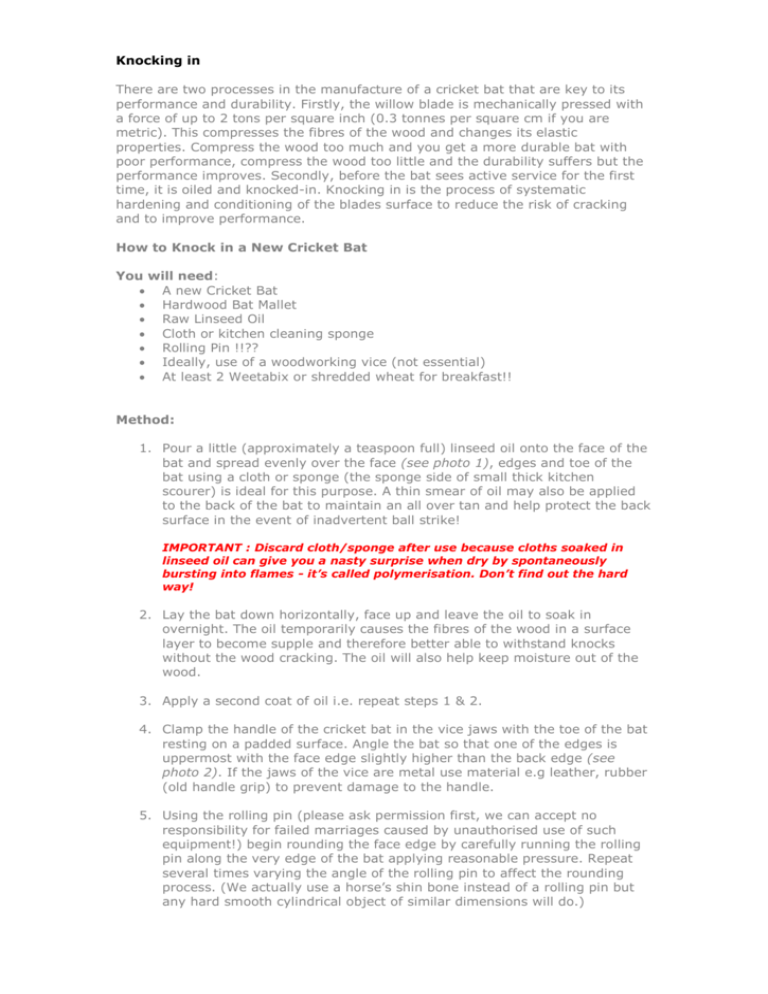Bat-Maintenance-Knocking-In
advertisement

Knocking in There are two processes in the manufacture of a cricket bat that are key to its performance and durability. Firstly, the willow blade is mechanically pressed with a force of up to 2 tons per square inch (0.3 tonnes per square cm if you are metric). This compresses the fibres of the wood and changes its elastic properties. Compress the wood too much and you get a more durable bat with poor performance, compress the wood too little and the durability suffers but the performance improves. Secondly, before the bat sees active service for the first time, it is oiled and knocked-in. Knocking in is the process of systematic hardening and conditioning of the blades surface to reduce the risk of cracking and to improve performance. How to Knock in a New Cricket Bat You will need: A new Cricket Bat Hardwood Bat Mallet Raw Linseed Oil Cloth or kitchen cleaning sponge Rolling Pin !!?? Ideally, use of a woodworking vice (not essential) At least 2 Weetabix or shredded wheat for breakfast!! Method: 1. Pour a little (approximately a teaspoon full) linseed oil onto the face of the bat and spread evenly over the face (see photo 1), edges and toe of the bat using a cloth or sponge (the sponge side of small thick kitchen scourer) is ideal for this purpose. A thin smear of oil may also be applied to the back of the bat to maintain an all over tan and help protect the back surface in the event of inadvertent ball strike! IMPORTANT : Discard cloth/sponge after use because cloths soaked in linseed oil can give you a nasty surprise when dry by spontaneously bursting into flames - it’s called polymerisation. Don’t find out the hard way! 2. Lay the bat down horizontally, face up and leave the oil to soak in overnight. The oil temporarily causes the fibres of the wood in a surface layer to become supple and therefore better able to withstand knocks without the wood cracking. The oil will also help keep moisture out of the wood. 3. Apply a second coat of oil i.e. repeat steps 1 & 2. 4. Clamp the handle of the cricket bat in the vice jaws with the toe of the bat resting on a padded surface. Angle the bat so that one of the edges is uppermost with the face edge slightly higher than the back edge (see photo 2). If the jaws of the vice are metal use material e.g leather, rubber (old handle grip) to prevent damage to the handle. 5. Using the rolling pin (please ask permission first, we can accept no responsibility for failed marriages caused by unauthorised use of such equipment!) begin rounding the face edge by carefully running the rolling pin along the very edge of the bat applying reasonable pressure. Repeat several times varying the angle of the rolling pin to affect the rounding process. (We actually use a horse’s shin bone instead of a rolling pin but any hard smooth cylindrical object of similar dimensions will do.) 6. Repeat steps 3 and 4 for the other face edge of the bat. NOTE: Rounding the edges (steps 3 to 5) is not absolutely essential but it minimises the risk of edge cracking through over enthusiastic initial use of the mallet in step 6. 7. Hold the bat vertically, blade up, with the end of the handle resting against your (padded) leg (see photo 3), remembering to take your mobile phone out of your pocket first! Take the bat mallet and, gently to begin with using a wrist action, knock the edge of the face near the toe area with the intention of rounding the relatively sharp edge. Hold the bat to the light and you will see that a dent has appeared in your brand new bat. Do not worry – I know you have paid a fortune for the bat but it has to be done! Systematically continue along the same edge until the dents merge to cover the playing length of the blade (the playing area of the bat is considered to be the area on the face of the bat below the sticker). Repeat for the other edge. 8. In a similar manner but with greater force, using full arm swings, strike the face of the bat with the mallet just sufficiently hard to cause a dent (see photo 4). Tip: Aim the mallet as if punching through the bat remembering that you are simulating a high speed ball striking a swinging bat. As for the edges, systematically cover the playing area of the face to merge the denting. You may wish to carry out this arm aching, body jarring, process in several short sessions. 9. Repeat steps 7 and 8 several times paying particular attention to the edge and toe areas where the force applied with the mallet should be gradually built up. The eventual aim is to even out the edges so that their whole surface has a smooth, rounded appearance and the face of the playing area also has a reasonably smooth even finish again. 5 or 6 fifteen minute sessions should be sufficient to knock-in your bat. TIPS and WARNINGS o o o o o o o To knock-in the face in the toe area of the bat (approximately 3 - 4 inches at the bottom) I find it more effective to hold the bat on the blade (see photo 5). Remember: wrist action for the edges, arm swings for the face Try not to concentrate on knocking one spot on the bat for too long. This is more likely to cause surface cracking and premature ageing of the bat. Do not attempt to knock-in the actual toe surface or back of the bat. Some people recommend the use of a cricket ball wrapped in a smelly old sock instead of a hardwood mallet but in our opinion you will never achieve the required level of power or control necessary for successful knocking-in with such equipment. It is recommended that on satisfactory completion of knocking–in a protective facing is applied to the playing surface of the bat. This will help minimise surface cracking, and provide additional protection for the edges. If you discover deep seam marks on your bat when you start using it, then this would indicate that the bat requires more knocking-in. o It is difficult to be too prescriptive but maybe you need to hit the face harder. Even after knocking-in, no matter how well the process is carried out, your bat will not be indestructible! Hit a ball hard enough in the wrong place on the bat and the bat will sustain damage. Most common damage is toe damage caused by catching the ball on the very edge of the toe (digging out a Yorker usually causes most damage as the ball gets trapped between the hard ground and toe of the bat). Edges and shoulders can also suffer significant damage. If the damage is not too severe the bat can be easily repaired without any significant effect on its performance provided that this work is carried out promptly. It is a case of ‘a stitch in time’. Minor surface cracking can be sealed with superglue without the need (and expense) of returning it for specialist repair. Photo1 Photo 2 Photo 3 Photo 4 Photo 5








